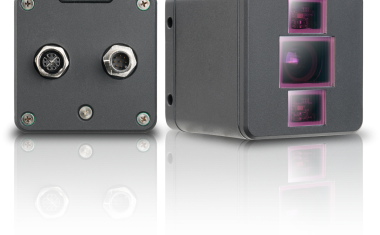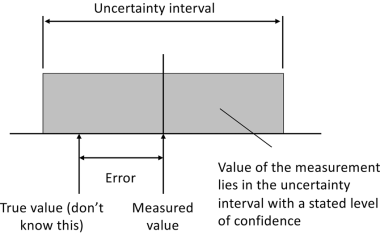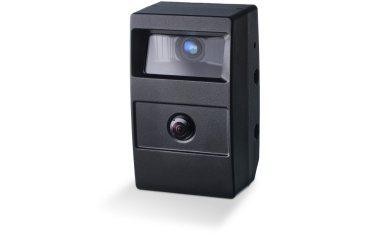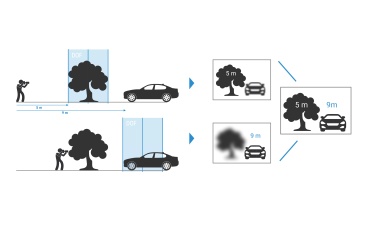Good Quality?
Near-Infrared images (900 nm ... 2,200 nm) allow to distinguish between objects that look quite similar in visible light. Thus quality criteria are detected that otherwise would remain invisible. Available NIR image sensors so far have been expensive and hard to manage, with rather low resolution and fairly high noise. Now there are new developments: Sensors based on Indium-Gallium-Arsenide in combination with CMOS readout technology.
When choosing the best apple from the basket, the hand moves almost automatically towards the flawless shiny surface. But if there are bruises underneath, the customer does not see. The InGaAs (Indium-Gallium-Arsenide) sensor, however, does: It is sensitive in the range of wavelengths, where water has its absorption maxima, at 1,450 nm and 1,950 nm. A bruise or an old apple holds less water which influences the absorption and reflection properties of the apple's surface. These changes can be detected by the InGaAs sensor. Based on this method, not only the quality of food can be inspected, but process gas analysis, paper and carton inspection, or the surveillance of vegetation growth is possible as well. Other examples for the usage of InGaAs sensors are the analysis of skin-moisture and skin-ageing or the inspection of airplane outer surfaces during de-icing processes in winter times. For a number of materials near infrared light penetrates deeper into the material than visible light, this enables a better inspection of deeper layers near to the surface. There are materials, e.g. Silicon, which are completely transparent for near infrared light rendering semiconductor inspection applications possible as silicon-wafer inspection, solar cell inspection, MEMS package analysis, and many more.
Even if the list of applications seems to be quite long, the price of InGaAs-technology has so far prevented a broader proliferation and use for industrial applications. Although the prices of InGaAs imagers have decreased consistently as well, the InGaAs-hybrid prices will still not be comparable to Si-CMOS imagers any time soon. That is why InGaAs-technology has to provide a substantial qualitative advantage for the inspection applications to be considered and accepted by the industrial user. This is the case, however, for many of the applications mentioned above.
InGaAs Hybrid Technology
Semiconductor material InGaAs is a ternary AIII-BV semiconductor for the spectral range from 900 nm to 1,700 nm and is thus generally usable for all light-detection applications in that spectral range. In order to help the camera manufacturer integrating the InGaAs image sensors into the camera-electronics, Andanta offers sensors being coupled with a CMOS read out integrated circuit (ROIC). The InGaAs photodiode array and the ROIC are tightly connected by means of an Indium-bump-bonding technology. At the output, the sensor provides an amplified analogue signal for further processing by the camera-electronics. The integrated electronics provides numerous features as choice of various operational and integration modes, of number of outputs, adjustable integration time and bandwidth. Also fast read out of partial images (Region of Interest), skimming (offset suppression) and internal test functions are included.
Default Mode for a Fast Start of Operation
In preset default mode the user works with just one output out of four. Four digital input-clocks (CLK, FSYNC, LSYNC, FIELD) are used, while a control register (for the advanced user) remains without signal. This mode only allows reading out full images in interlaced mode. Amplification gain and input bandwidth of the sensor are variably adjustable. As a result, the default mode allows a fast start of operation by the camera developer at reduced expenditure, low power consumption and moderate read out rate.
Modes for Professionals
The full performance of the sensor only unfolds, though, when using the control register. In this control mode the number of outputs can be chosen from one to four and partial images can be read out (ROI), while the size and location of the read-out window is selectable. Furthermore, the image information, once integrated, can be read out multiple times and the sequence of single pixel readout is adjustable as well. Thus, the sensor concept ensures a high degree of flexibility for the user. Depending on the application one will use a suitable sensor operation and integration mode:
- For a fast application a lower sensor resolution will be advantageous (320 x 256) and the controlled mode with four outputs will be chosen, while using the „Integration while Read" (IWR) mode. Additionally, using of Region of Interest (ROI) operation can be considered, which allows a read out rate of up to 14 kHz.
- For a high sensitivity application the user will choose a thermoelectrically cooled sensor and puts the gain on „high" for reducing the noise floor down to about 45 e-.
- When implementing a high-resolution application, the sensor with the highest standard resolution, FPA640x512, will be chosen. Even higher resolution sensors can be developed in the frame of a custom-specific contract.
All sensors are pluggable to commercially available sockets as well as solderable. For most of the industrial applications standard lenses are applicable.
Standard Products and New Developments
The standard InGaAs matrix arrays feature a 320 x 256 and a 640 x 512 pixel resolution for the spectral range of 900 nm to 1,700 nm. If the device is thermoelectrically cooled, it comes in a hermetic 28-pin Kovar package with one-stage thermoelectric cooler and sapphire window. For the lower resolution matrix with 320 x 256-pixels there is also an uncooled version available using a hermetic 44-pin ceramics package with sapphire window. The uncooled version forms a good entry into InGaAs-techniques for the starting user. It can be operated at ambient temperature; the device is compact and easy to integrate. The low power consumption and low mass also make it suitable for portable inspection and night vision applications.
Extension of the Spectral Range
The spectrally extended sensors for the wavelength range of 1,200 nm to 2,200 nm are, for reliable infrared operation, exclusively delivered in 28-pin Kovar package with one-stage thermoelectric cooling.
Extending the spectral sensitivity into the visible part of the spectrum (VisGaAs), below the wavelength of 900 nm, is part of a developmental program currently ongoing. Developing even higher resolution standard devices, e.g. with 1,024 x 1,024 elements, is considered as well. Technologically such a sensor would be feasible already today, but the higher sensor price might not be attractive enough for the industrial user.
The Andanta InGaAs matrix arrays feature a very good price performance ratio. Therefore they are attractive for camera manufacturers as well as for manufacturers of spectrometers, analytic mea-surement devices and other scientific optoelectronic systems for industrial inspection. The system developer will get extensive help when designing-in the image sensors. The sensors are also long-term available and not threatened easily by obsolescence.











